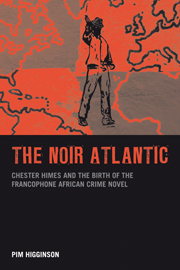Book contents
- Frontmatter
- Contents
- Acknowledgements
- Introduction: The Frivolous Literary
- 1 “Pas de littérature”: Abasse Ndione and the Rise of Crime
- 2 Minor Mistranslations: Simon Njami and the Making of a Parisianist Himes
- 3 Crime Pays: Achille Ngoye and the Série noire
- 4 Ethnographic Erotics: Bolya and the Writing of the Other
- 5 Terreur Rose: Kouty, mémoire de sang and the Gendering of Noir
- 6 Going out Blazing: Mongo Beti's Last Two Novels
- Bibliography
- Index
5 - Terreur Rose: Kouty, mémoire de sang and the Gendering of Noir
- Frontmatter
- Contents
- Acknowledgements
- Introduction: The Frivolous Literary
- 1 “Pas de littérature”: Abasse Ndione and the Rise of Crime
- 2 Minor Mistranslations: Simon Njami and the Making of a Parisianist Himes
- 3 Crime Pays: Achille Ngoye and the Série noire
- 4 Ethnographic Erotics: Bolya and the Writing of the Other
- 5 Terreur Rose: Kouty, mémoire de sang and the Gendering of Noir
- 6 Going out Blazing: Mongo Beti's Last Two Novels
- Bibliography
- Index
Summary
Women and noir
Among the aspects of this ethnographic apparatus that Bolya retains, one of the most important is his critique of the implicit gendering of racial paradigms so problematically yet powerfully evident throughout Himes' work. In Himes, race is always-already inflected with a constitutive sexual component that is a—if not the—determining factor in relations between white and black. This racialized sexuality is intimately connected to ascriptions of crime and violence, as Sander Gilman demonstrated in his now famous essay “Black Bodies, White Bodies.” In the Harlem series, as we have already seen in the case of the first volume's titular femme fatale Imabelle, women are both an object of desire and the catalyst for the criminal activity that permeates the novel. Yet, beyond Imabelle's dangerous sexuality, there lie the powers of whiteness creating the context and language by which Harlem's essential criminality is determined and the textual register in which the terms of racial difference are inscribed and by which they are disseminated. Bolya makes obvious the component of desire structuring the ethnographic relationship that, while an essential component of his Harlem, Himes leaves far less explicitly theorized.
Bolya's “female other” is constructed through the tropes and desires of ethnography itself, but examinations of gender through the African crime novel have taken other directions also. Malian author Aïda Mady Diallo's novel, Kouty, mémoire de sang (1998, 2002) pursues this issue from a rather different perspective. While Diallo, like Bolya and the other authors in the study (all of whom are men), draws on this particular emphasis of Himes, she explores gender within the genre by multiplying and complicating the frames of reference.
- Type
- Chapter
- Information
- The Noir AtlanticChester Himes and the Birth of the Francophone African Crime Novel, pp. 140 - 167Publisher: Liverpool University PressPrint publication year: 2011



